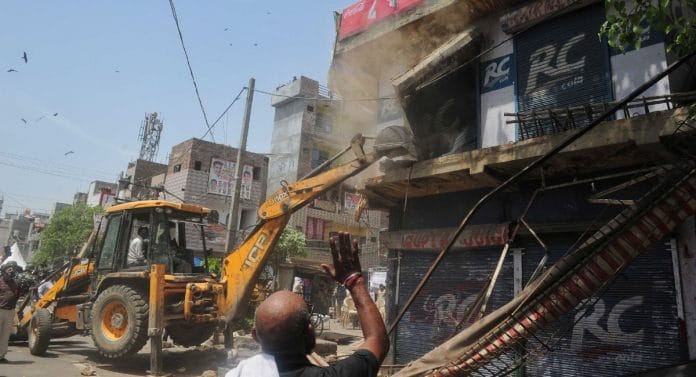New Delhi: A controversy is raging over the removal of alleged “illegal encroachments” in Delhi’s Jahangirpuri area.
Visuals are viral of CPI(M) leader Brinda Karat blocking a JCB bulldozer Wednesday, citing an order of the Supreme Court to challenge the legality of the demolition drive against shops and residences in Jahangirpuri.
Another viral photo is that of UK PM Boris Johnson, who climbed onto a bulldozer at British company JCB’s new factory in Gujarat.
With the use of bulldozers to carry out demolition drives finding mention in multiple headlines of late, one is bound to think about how these earthmovers managed to make a place for themselves in the political discourse.
Here’s a look at the over-100-year history of the machine, and a term that initially described something completely different.
Also Read: ‘Bharatanatyam’ in Ukraine to bulldozer in Jahangirpuri, action just doesn’t stop for TV news
Holt’s prototype — tanks
The term “bulldozer” traces its origins to late 19th-century American English. The first recorded use of the term goes back to the year 1876 when, ahead of the US presidential election, it was used to refer to the “intimidation” of African-American voters by “violence” in the southern state of Louisiana.
The bulldozer, as we know it today, was first developed as an alternative to traditional tractors in 1904 by Benjamin Holt. An inventor and grain harvester, Holt tested his prototype — which later revolutionised the farming business — on his farm in California.
According to the Washington Post, Holt’s proto-bulldozer contraption was a “diesel-powered traction machine” capable of moving “over land too soft to support horsedrawn or wheeled tractors”.
The following decade, the principle that was the basis of Holt’s experiment with his farming machinery was found to be applicable for military use. This led to the development of tanks in 1916 during the First World War.
“The word ‘tank’ originated because of the way in which the new weapons were shipped overseas during the First World War,” the Post report says. “The armour-plated machines with tractor treads considered a secret weapon. So when they were shipped they were identified only as water tanks for British troops in Egypt.”
Cummings, McLeod patent
The official patent for the world’s first bulldozer, however, was held by James Cummings and John McLeod. The two men from Morrowville in Kansas were granted the patent in 1925, two years after they applied for it.
The state tourism department of Kansas has since claimed to be home to the world’s first bulldozer, citing Cummings and McLeod’s invention as “an oak blade crudely mounted on a Fordson tractor”. Even today, a replica of this bulldozer sits in Morrowville’s Cummings Park.
Soon after the patent was granted, the dictionary meaning of “bulldozer” was expanded to include the machine.
Ever since, US-based Caterpillar, German-Swiss firm Liebherr and Japan’s Komatsu have emerged as the foremost global manufacturers of bulldozers.
Also Read: ‘Bulldozer’ the latest fad in UP
‘JCB bulldozer’ in India
In India, the term bulldozer has come to be synonymous with JCB, a British manufacturer.
Founded in 1945, J.C. Bamford Excavators Ltd, or JCB, first entered the Indian market in 1979 as part of a joint venture with local engineering firm Escorts. The firm set up its first factory in Ballabhgarh, on the outskirts of Delhi, before expanding to other cities.
It wasn’t until the late 2000s when JCB’s revenue in India began to grew exponentially as the British parent company bought out Escorts’ stake. To expand its operations, JCB took advantage of downsizing by other foreign construction companies and disinvestments from India during the global financial crisis, according to a 2014 Live Mint report.
“Over the years, JCB has invested Rs 2,000 crores in India and today employs 5,000 people in its Indian operations… It has also built and supported an indigenised supply chain for the manufacturing of its products. Over 380 world-class Indian suppliers are aligned to JCB’s group objectives and have grown along with JCB through various supplier development initiatives,” reads the company website.
In 2020, amid the Covid-19 pandemic, JCB accounted for 35,300 units of construction equipment out of a total of 65,300 sold in India, the Economic Times reported, citing data from the Indian Construction Equipment Manufacturers Association.
(Edited by Amrtansh Arora)
Also Read: ‘No one listened’: Jahangirpuri residents cry after bulldozers raze ‘illegal’ shops & structures






